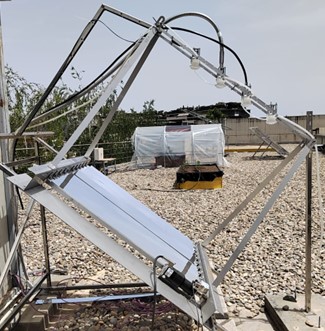The Full Spectrum Solar (FSS) unit of the SolDAC system is managing the incident solar radiation by spectrally splitting the incident photons in two flows: the ‘cold’ and the ‘hot’ one. The cold flow of photons comprises photons ranging from 300 nm to 1100 nm and the hot flow those in the near-infrared region from 1100 nm and above. To do so, the incident irradiance is concentrated by a Fresnel concentrator composed of 10 parabolic-shaped reflectors that focus sunlight on the receiver plane. The receivers play a dual function: (1) Convert and adapt the linear incident concentrated intensity into a punctual focus that is later guided by an optical-fibre bundle; (2) Split the incident concentrated spectrum by an absorption liquid filter that absorbs the hot flow of photons to produce heat and transmits the lower wavelength ones to be light guided. The hot flow of photons is later used by the direct air capture unit of the SolDAC system to enhance the CO2 adsorption and the cold flow of photons is converted into electrons either by a photovoltaic cell or by a photoanode of the photoelectrochemical unit of SolDAC.

At present, all the components of the FSS have been fabricated and assembled, including the tracking and control systems. Figure 1 shows the fabricated prototype installed at the facilities of the University of Lleida. In the photograph, the platform of reflectors, tilted 40º, and four receivers (two of them with the optical-fibre bundles connected) can be seen. Currently, we are conducting the thermal and the spectral full characterisations of the FSS prior to be coupled and assessed with the rest of the SolDAC units: water harvester, direct air capture and photoelectrochemical reactor. Figure 2 illustrates the spectral splitting receiver.

Written by UdL